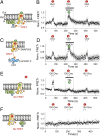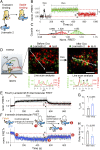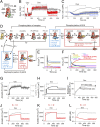Muscarinic receptor regulates extracellular signal regulated kinase by two modes of arrestin binding
- PMID: 28652372
- PMCID: PMC5514713
- DOI: 10.1073/pnas.1700331114
Muscarinic receptor regulates extracellular signal regulated kinase by two modes of arrestin binding
Abstract
Binding of agonists to G-protein-coupled receptors (GPCRs) activates heterotrimeric G proteins and downstream signaling. Agonist-bound GPCRs are then phosphorylated by protein kinases and bound by arrestin to trigger desensitization and endocytosis. Arrestin plays another important signaling function. It recruits and regulates activity of an extracellular signal-regulated kinase (ERK) cascade. However, molecular details and timing of ERK activation remain fundamental unanswered questions that limit understanding of how arrestin-dependent GPCR signaling controls cell functions. Here we validate and model a system that tracks the dynamics of interactions of arrestin with receptors and of ERK activation using optical reporters. Our intermolecular FRET measurements in living cells are consistent with β-arrestin binding to M1 muscarinic acetylcholine receptors (M1Rs) in two different binding modes, transient and stable. The stable mode persists for minutes after agonist removal. The choice of mode is governed by phosphorylation on key residues in the third intracellular loop of the receptor. We detect a similar intramolecular conformational change in arrestin in either binding mode. It develops within seconds of arrestin binding to the M1 receptor, and it reverses within seconds of arrestin unbinding from the transient binding mode. Furthermore, we observed that, when stably bound to phosphorylated M1R, β-arrestin scaffolds and activates MEK-dependent ERK. In contrast, when transiently bound, β-arrestin reduces ERK activity via recruitment of a protein phosphatase. All this ERK signaling develops at the plasma membrane. In this scaffolding hypothesis, a shifting balance between the two arrestin binding modes determines the degree of ERK activation at the membrane.
Keywords: ERK; GPCR; arrestin; muscarinic receptor; receptor kinase.
Conflict of interest statement
The authors declare no conflict of interest.
Figures





Similar articles
-
Muscarinic receptor antagonists activate ERK-CREB signaling to augment neurite outgrowth of adult sensory neurons.Neuropharmacology. 2018 Dec;143:268-281. doi: 10.1016/j.neuropharm.2018.09.020. Epub 2018 Sep 22. Neuropharmacology. 2018. PMID: 30248305
-
A phosphorylation cluster of five serine and threonine residues in the C-terminus of the follicle-stimulating hormone receptor is important for desensitization but not for beta-arrestin-mediated ERK activation.Mol Endocrinol. 2006 Nov;20(11):3014-26. doi: 10.1210/me.2006-0098. Epub 2006 Aug 3. Mol Endocrinol. 2006. PMID: 16887887
-
The stability of the G protein-coupled receptor-beta-arrestin interaction determines the mechanism and functional consequence of ERK activation.J Biol Chem. 2003 Feb 21;278(8):6258-67. doi: 10.1074/jbc.M212231200. Epub 2002 Dec 6. J Biol Chem. 2003. PMID: 12473660
-
Beta-arrestins as regulators of signal termination and transduction: how do they determine what to scaffold?Cell Signal. 2011 Apr;23(4):621-9. doi: 10.1016/j.cellsig.2010.10.004. Epub 2010 Oct 12. Cell Signal. 2011. PMID: 20946952 Review.
-
Evolving concepts in G protein-coupled receptor endocytosis: the role in receptor desensitization and signaling.Pharmacol Rev. 2001 Mar;53(1):1-24. Pharmacol Rev. 2001. PMID: 11171937 Review.
Cited by
-
β-arrestin1 and 2 exhibit distinct phosphorylation-dependent conformations when coupling to the same GPCR in living cells.Nat Commun. 2022 Sep 26;13(1):5638. doi: 10.1038/s41467-022-33307-8. Nat Commun. 2022. PMID: 36163356 Free PMC article.
-
Molecular mechanism of GPCR-mediated arrestin activation.Nature. 2018 May;557(7705):452-456. doi: 10.1038/s41586-018-0077-3. Epub 2018 May 2. Nature. 2018. PMID: 29720655 Free PMC article.
-
Scaffolding mechanism of arrestin-2 in the cRaf/MEK1/ERK signaling cascade.Proc Natl Acad Sci U S A. 2021 Sep 14;118(37):e2026491118. doi: 10.1073/pnas.2026491118. Proc Natl Acad Sci U S A. 2021. PMID: 34507982 Free PMC article.
-
Distinct activation mechanisms of β-arrestin-1 revealed by 19F NMR spectroscopy.Nat Commun. 2023 Nov 29;14(1):7865. doi: 10.1038/s41467-023-43694-1. Nat Commun. 2023. PMID: 38030602 Free PMC article.
-
Membrane phosphoinositides allosterically tune β-arrestin dynamics to facilitate GPCR core engagement.bioRxiv [Preprint]. 2025 Jul 23:2025.06.06.658200. doi: 10.1101/2025.06.06.658200. bioRxiv. 2025. PMID: 40501946 Free PMC article. Preprint.
References
-
- Doan T, Mendez A, Detwiler PB, Chen J, Rieke F. Multiple phosphorylation sites confer reproducibility of the rod’s single-photon responses. Science. 2006;313:530–533. - PubMed
Publication types
MeSH terms
Substances
Grants and funding
LinkOut - more resources
Full Text Sources
Other Literature Sources
Molecular Biology Databases
Research Materials
Miscellaneous

